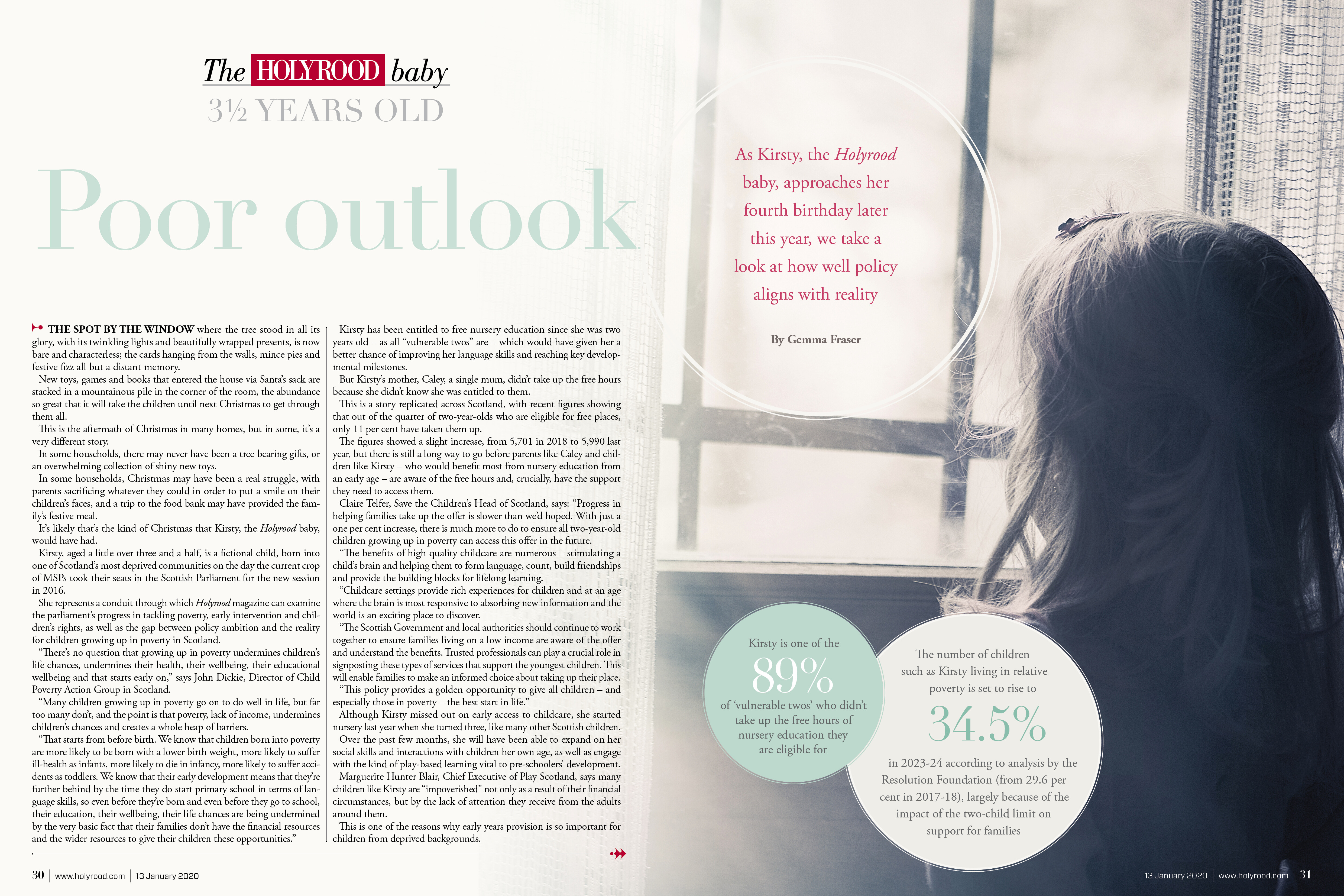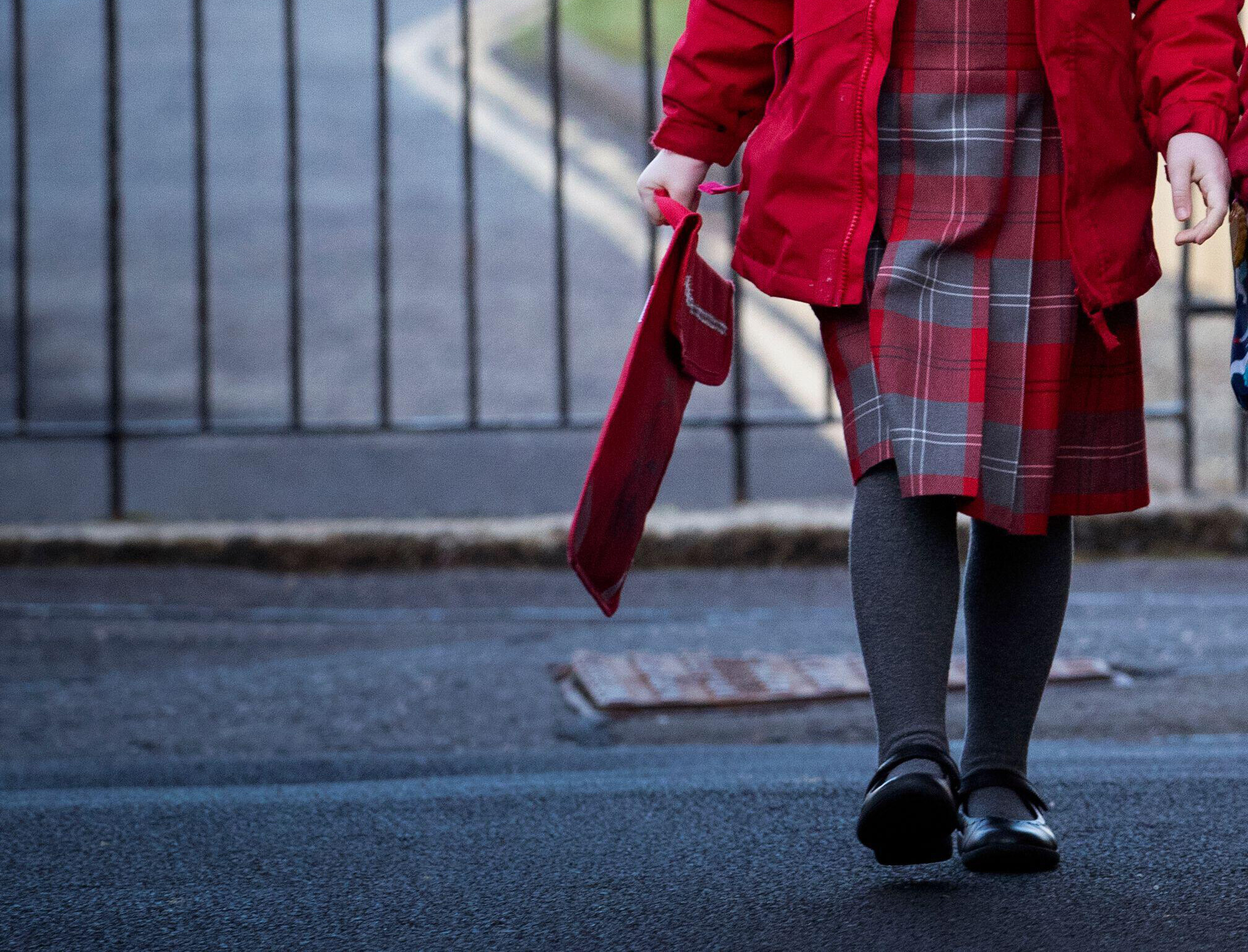The Holyrood baby: More likely to live in poverty now than the day she was born
Taking inspiration from an independence referendum campaign video in 2014, in which Nicola Sturgeon asked people to imagine a child called Kirsty and consider what kind of Scotland they wanted her to grow up in, five years ago Holyrood gave birth to its own baby Kirsty.
Born on 12 May 2016, the first day of the last parliament, into one of the most deprived areas of Scotland, we challenged MSPs to answer this question: “What kind of life does Scotland want Kirsty to have and what will you do to support or hinder that?”
In a newspaper column at the time, the First Minister said: “Let’s all resolve that, when this parliament dissolves five years from now, we’ll be able to say we’ve done everything we can to give all of Scotland’s young people the best possible future.”
But five years on, has that been achieved? Did Scotland’s politicians make life better for children like Kirsty growing up in poverty in Scotland and, as we begin a new five-year parliamentary term and Kirsty starts school, what should the priorities be to tackle child poverty and inequality over the next five years?
“I suppose the top line, unfortunately, is that [things] have got worse,” says John Dickie, director of the Child Poverty Action Group.
“More children are living in poverty, the risk of a baby being born into poverty in Scotland now is greater than it was when Kirsty was born, largely as a result of the extraordinary cuts we've seen to UK social security support for families, the two-child limit, the benefit cap, the increasing impact they’ve had on families alongside the value of Universal Credit and child benefit being reduced in real terms over that period.
“At the same time, [she is] more likely to be a child born into a working family in poverty. So an increasing proportion of children in poverty and babies being born into poverty are being born into poverty where at least one parent works, but the reality of the nature of our labour market – insecurity, limited hours, low pay – that parents face means that too often families are still living in poverty despite being in work.
“So in that sense the top line is that the risk of being born into poverty now is actually greater than in 2016. But having said that, the reality is that some very real positive progress has been made in Scotland and looking at it through a Holyrood lens, the support that has been put in place by the Holyrood parliament and the Scottish Government has made a real difference and has improved the situation for Kirsty and for her peers, and for those who are being born into families now, compared to what it otherwise would have been.”
The Child Poverty (Scotland) Act 2017 set out a tough set of targets to reduce relative child poverty to under 10 per cent by 2030, while absolute child poverty, persistent poverty and combined low income and material deprivation must be below five per cent.
The act also sets interim targets for 2023-24, with the aim of reducing relative poverty to 18 per cent, absolute poverty to 14 per cent and low income/material deprivation and persistent poverty to eight per cent by that date.
Setting targets does not in itself necessarily change anything, but there have also been actions to back those up.
The real gamechanger in the eyes of child poverty campaigners is the Scottish Child Payment, a payment of £10 per week to families on low incomes with children under six.
Kirsty’s mum, Caley, has been glad of the extra money since it began being paid out in February this year, but this may only be a temporary relief and it may not be enough.
The payment is due to be expanded to cover children aged six to 16 by late 2022, but Westminster’s Scottish Affairs Committee recently heard this rollout could be hindered by a lack of data from the DWP, meaning Caley could lose the payment when Kirsty turns six next year and face a gap before over-sixes become eligible.
As someone on Universal Credit, Caley also faces losing £20 a week if the UK Government goes ahead with plans to reverse the £20 uplift that was brought in during the pandemic and she is worried about how she will make ends meet if this happens.
Other support has been introduced as social security powers were devolved to Scotland. The Best Start Grant, rolled out between December 2018 and June 2019 to replace and expand on the UK Sure Start Maternity Grant, is made up of three payments: a pregnancy and baby payment of £606 for a first child or £303 for subsequent children, an early learning payment of £252.50 when the child is two or three and a school start payment of £252.50 when the child is ready to start school.
From August 2019, Best Start Foods, a prepaid card that can be used by pregnant women and parents of children under three to buy healthy foods, replaced UK Healthy Start.
Best Start Foods payments increased from August 2021 and currently the rates are £18 every four weeks during pregnancy, £36 every four weeks until the child is one and then £18 every four weeks between the ages of one and three.
Alongside this there was the introduction of the baby box; the planned expansion of free childcare to 30 hours a week, originally scheduled for August 2020 but delayed until August 2021; the attempt to improve children’s rights by incorporating the UNCRC into Scots law; the recent launch of the Scottish Milk and Healthy Snack Scheme for pre-school children from August 2021; the extension of free school meals to school holidays for eligible children and the forthcoming expansion of free school meals to all primary children by August 2022, starting with primary fours and fives during this school year.
Pilots of the new Child Disability Payment also began in July and there are extra one-off coronavirus hardship payments this year of £130 to all low-income households and two £100 payments for families in receipt of free school meals.

One of Holyrood's previous articles on "Kirsty"
But despite the extra support for low-income families introduced in the last few years, there are concerns this will not be enough.
“The concern is that, and there are developments in progress in specific policy areas, but it’s maybe not on the scale that’s sufficient in order for us to make significant progress, or happening urgently enough in order to kind of make progress towards the child poverty targets, both the interim and the targets for 2030,” says Claire Telfer, chief executive of Save the Children in Scotland.
In its June 2021 report, the Poverty and Inequality Commission warned: “Unless very significant further action is taken now, the Scottish Government is going to miss the interim and final [child poverty] targets by a long way, leaving children and families locked into poverty.
“The targets can be met, but the Scottish Government must deliver action at a much greater scale and pace, and with significantly higher levels of investment, if it is to do so. Meeting the child poverty targets must be a priority for the new Scottish Government, and it must act now.”
The commission said the action being taken by the Scottish Government was “not on a scale that is sufficient to meet the interim or final targets,” and would not have been enough even without the impact of the pandemic.
The commission has also said there was not enough evidence of how the actions in the Scottish Government’s Child Poverty Delivery Plan were expected to contribute towards child poverty targets and not enough focus on outcomes.
Ahead of the Holyrood election in May, the SNP made a manifesto commitment to double the Scottish Child Payment to £20 a week over the course of this parliament, as did all the opposition parties, but with the most recent figures putting child poverty at around 26 per cent and rising even before the pandemic, and the country looking set to miss its interim target in two years’ time, campaigners are urging for this rise to take place as soon as possible.
“If government follows through and delivers on the doubling of the Scottish Child Payment, but does that sooner rather than later, then it starts to get us on a trajectory which means that 23-24 target could be met,” says Dickie.
“And that’s then about policy choices and political choices and where resources are allocated within the coming Scottish budget and the budget after that.”
Telfer agrees: “We’re calling for the government to at least double the Scottish Child Payment and to do that now, as quickly as possible, because we know that children and families need that support now.
“There was cross-party support for that policy across the manifestos during the election, but it’s the timing now that’s critical. And the sooner that we have that in place, the sooner we can look at how well it’s being taken up and if further efforts are needed”.
Having analysed progress on child poverty, in March the Fraser of Allander Institute reported – the bad news was that to do that using the Scottish Child Payment alone, it would mean a payment of £40 a week at a cost of around half a billion a year.
While increasing the Scottish Child Payment is seen as the main lever for a fast reduction in child poverty that would meet the interim targets, more fundamental change around access to work and making work pay are needed to achieve the 2030 ones.
Dickie says it’s about “removing the barriers to employment that too many parents face and improving the nature of that employment so that work plays a much bigger role in preventing poverty and lifting children out of poverty.”
This includes removing childcare barriers, increasing pre-school childcare hours to 50 per week and extending wraparound childcare beyond the school day; looking at the quality of jobs and the pay that is available; ensuring there are no transport barriers to childcare, learning or work; and ensuring housing costs continue to be a focus, because child poverty after housing costs is significantly higher than before housing costs.

Telfer also mentions issues around debt, and both Dickie and Telfer note a need to focus more on the priority groups who have been identified as being most at risk of poverty, such as families with babies, single-parent families, ethnic minority families and families where there is a disability, and what they need.
Dickie concludes: “I think there has been a real will, there has been real improvement, there has been real additional resources, real money has been put into struggling families’ pockets that’s made a big difference for children in Scotland, but the reality is in order to meet that target to reduce child poverty to even just less than 18 per cent will require a doubling down on what’s already been committed to and … [to] build on it to make sure that resources are put in place to actually meet those targets and to set a course for achieving the 2030 child poverty targets.”
With child poverty no less an issue than it was five years ago and more action needed if targets that all parties have backed are to be met, as we begin the new parliamentary session, Holyrood asks the same question we did of MSPs in 2016: “What kind of life does Scotland want Kirsty to have and what will you do to support or hinder that?”
Holyrood Newsletters
Holyrood provides comprehensive coverage of Scottish politics, offering award-winning reporting and analysis: Subscribe